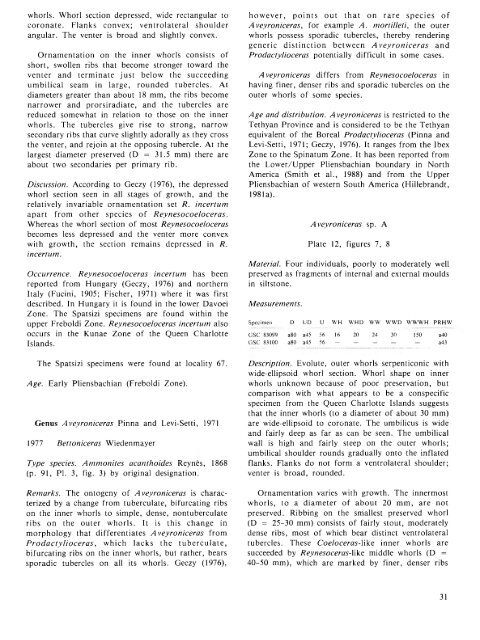PLIENSBACHIAN (LOWER JURASSIC) BIOSTRATIGRAPHY AND ...
PLIENSBACHIAN (LOWER JURASSIC) BIOSTRATIGRAPHY AND ...
PLIENSBACHIAN (LOWER JURASSIC) BIOSTRATIGRAPHY AND ...
Create successful ePaper yourself
Turn your PDF publications into a flip-book with our unique Google optimized e-Paper software.
whorls. Whorl section depressed, wide rectangular to<br />
coronate. Flanks convex; ventrolateral shoulder<br />
angular. The venter is broad and slightly convex.<br />
Ornamentation on the inner whorls consists of<br />
short, swollen ribs that become stronger toward the<br />
venter and terminate just below the succeeding<br />
umbilical seam in large, rounded tubercles. At<br />
diameters greater than about 18 mm, the ribs become<br />
narrower and prorsiradiate, and the tubercles are<br />
reduced somewhat in relation to those on the inner<br />
whorls. The tubercles give rise to strong, narrow<br />
secondary ribs that curve slightly adorally as they cross<br />
the venter, and rejoin at the opposing tubercle. At the<br />
largest diameter preserved (D = 31.5 mm) there are<br />
about two secondaries per primary rib.<br />
Discussion. According to Geczy (1976), the depressed<br />
whorl section seen in all stages of growth, and the<br />
relatively invariable ornamentation set R. incertum<br />
apart from other species of R eyneso coelo cera s.<br />
Whereas the whorl section of most Reynesocoeloceras<br />
becomes less depressed and the venter more convex<br />
with growth, the section remains depressed in R.<br />
incertum .<br />
Occurrence. R eynesocoeloceras incertum has been<br />
reported from Hungary (Geczy, 1976) and northern<br />
Italy (Fucini, 1905; Fischer, 1971) where it was first<br />
described. In Hungary it is found in the lower Davoei<br />
Zone. The Spatsizi specimens are found within the<br />
upper Freboldi Zone. Reynesocoeloceras incertum also<br />
occurs in the Kunae Zone of the Queen Charlotte<br />
Islands.<br />
The Spatsizi specimens were found at locality 67.<br />
Age. Early Pliensbachian (Freboldi Zone).<br />
Genus Aveyroniceras Pinna and Levi-Setti, 1971<br />
1977 Bettoniceras Wiedenmayer<br />
Type species. A m m onites acanthoides Reynes, 1868<br />
(p. 91, PI. 3, fig. 3) by original designation.<br />
Rem arks. The ontogeny of Aveyroniceras is characterized<br />
by a change from tuberculate, bifurcating ribs<br />
on the inner whorls to simple, dense, nontuberculate<br />
ribs on the outer whorls. It is this change in<br />
morphology that differentiates A veyroniceras from<br />
P ro d a c ty lio c e ra s, which lacks the tuberculate,<br />
bifurcating ribs on the inner whorls, but rather, bears<br />
sporadic tubercles on all its whorls. Geczy (1976),<br />
however, points out that on rare species of<br />
Aveyroniceras, for example A . m ortilleti, the outer<br />
whorls possess sporadic tubercles, thereby rendering<br />
generic distinction between A v e y ro n ic e ra s and<br />
Prodactylioceras potentially difficult in some cases.<br />
Aveyroniceras differs from Reynesocoeloceras in<br />
having finer, denser ribs and sporadic tubercles on the<br />
outer whorls of some species.<br />
A ge and distribution. Aveyroniceras is restricted to the<br />
Tethyan Province and is considered to be the Tethyan<br />
equivalent of the Boreal Prodactylioceras (Pinna and<br />
Levi-Setti, 1971; Geczy, 1976). It ranges from the Ibex<br />
Zone to the Spinatum Zone. It has been reported from<br />
the Lower/Upper Pliensbachian boundary in North<br />
America (Smith et al., 1988) and from the Upper<br />
Pliensbachian of western South America (Hillebrandt,<br />
1981a).<br />
Aveyroniceras sp. A<br />
Plate 12, figures 1, 8<br />
Material. Four individuals, poorly to moderately well<br />
preserved as fragments of internal and external moulds<br />
in siltstone.<br />
Measurements.<br />
Specim en D UD U W H W H D W W W W D W W W H P R H W<br />
G SC 83099 a80 a45 56 16 20 24 30 150 a40<br />
G SC 83100 a80 a45 56 - - - - — a43<br />
Description. Evolute, outer whorls serpenticonic with<br />
wide-ellipsoid whorl section. Whorl shape on inner<br />
whorls unknown because of poor preservation, but<br />
comparison with what appears to be a conspecific<br />
specimen from the Queen Charlotte Islands suggests<br />
that the inner whorls (to a diameter of about 30 mm)<br />
are wide-ellipsoid to coronate. The umbilicus is wide<br />
and fairly deep as far as can be seen. The umbilical<br />
wall is high and fairly steep on the outer whorls;<br />
umbilical shoulder rounds gradually onto the inflated<br />
flanks. Flanks do not form a ventrolateral shoulder;<br />
venter is broad, rounded.<br />
Ornamentation varies w'ith growth. The innermost<br />
whorls, to a diameter of about 20 mm, are not<br />
preserved. Ribbing on the smallest preserved w'horl<br />
(D = 25-30 mm) consists of fairly stout, moderately<br />
dense ribs, most of which bear distinct ventrolateral<br />
tubercles. These Coeloceras-like inner whorls are<br />
succeeded by Reynesoceras-like middle whorls (D =<br />
40-50 mm), which are marked by finer, denser ribs

















